#coastal conifers
Text
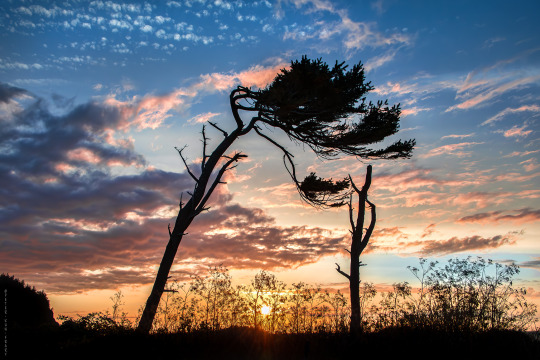
Windswept conifer at Point Wilson in Fort Worden State Park.
#coastal conifers#original photography#Point Wilson#fort worden state park#washington state#pacific northwest#washington landscape#sunset colors
60 notes
·
View notes
Text




Ireland - September 2023 (2) (3) (4) by Aljaž Gošnak
Via Flickr:
(2) Rock of Cashel
(3) Deck of Cards & St. Colman's Cathedral / Cobh
(4) Rossbeigh Strand
#forest#landscape#conifers#towers#historic buildings#houses#churches#beach#rocky shore#coastal#ireland#county tipperary#county cork#county kerry
9 notes
·
View notes
Text
Dependable Green
Ælfhild Astrædottir
This poem was first published, today, in Salish Magazine, a free online magazine that publishes articles and artwork exploring Salish Sea ecosystems. This is my contribution. I encourage interested parties to follow the link and peruse the rest of the magazine. You can listen to me read my poem on the magazine site. It's my first time being published in a magazine: cheers!
Green is the call sign of summer
When chlorophyll works overtime
Gathering in wavelengths of reds and blues
Spinning those threads of sunshine,
Faithfully fueling the Plant Kingdom
(And dowager queen cyanobacteria besides)
From darling Mnium spinulosum moss
To gracefully sweeping hemlocks where they abide,
In summer the forests are painted with a thousand shades
Of vivacious, variegated, verdure
From sun touched madrone leaves
To shadowed webs of twinflower,
Then comes autumn the season of change
The deciduous leaves layoff their chlorophyll
Indulging in bright yellows and bold reds
Before they too are cast off and still,
Oh, but those stalwart evergreens
They hold tight to their chlorophyll yet
They weather autumn storms with their leaves intact
Sheltering their animal neighbors from the wet,
Then comes winter and the forests fill with skeletons
Tangled thickets of bare shrubs and barer trees
Ah, but the evergreens fill in their spaces
Vibrant life of red cedar and pacific rhodys,
When the deer are scrounging for tidbits
When the songbirds need a break from the cold
When the underground is limping by on reserves
Evergreen offerings are more precious than gold,
All winter the conifers tall and proud
Stand guard on our bluffs, our hills and our vales
A mosaic of malachite holding together our forests
Buffering all from the fiercest winter gales,
Then comes spring and the sweet sap rises
Buds unfurl tender leaves and pollen fills the air
And amidst all this new life and color
The valiant evergreens are still green and still there.
© Ælfhild Astrædottir 2023
#Ælfhild Astrædottir#poetry#original poetry#evergreens#Salish Magazine#Salish Sea#conifers#pnw#pnw poetry#pacific northwest#forests#coastal ecosystems#tumblr poets#tumblr authors#magazine#first magazine contribution#yay
3 notes
·
View notes
Text







2 notes
·
View notes
Text
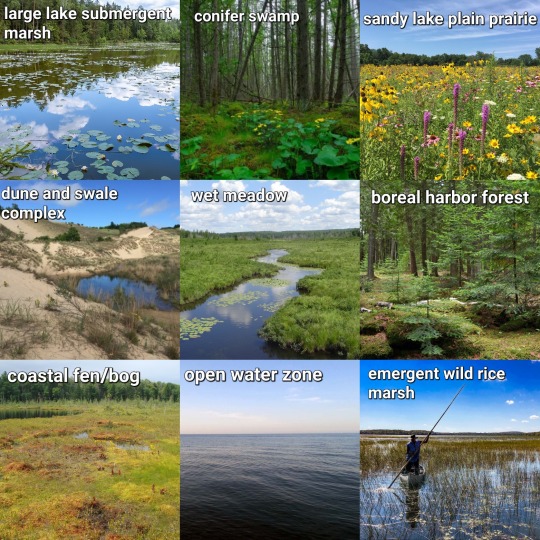
#poll#great lakes#ecosystems#ecology#marsh#lake#lakeposting#freshwater#wetlands#fen#bog#cattail#wild rice#forest#boreal#boreal forest#prairie#dune#dunes#dune and swale#estuary#delta#wet meadow#swamp
3K notes
·
View notes
Text

Knobbly knees <3
Wind-swept coastal gorse bushes, long since overshadowed by conifer plantation.
38 notes
·
View notes
Text
How to Identify Morels
Originally posted at my website at https://rebeccalexa.com/how-to-identify-morels/ - Click here to learn more about the How to Identify article series.
Name: True morels (Morchella spp.)
Range and typical habitat(s): Widespread throughout temperate North America, Europe, New Zealand and Australia; less commonly reported in South America, Asia, and coastal Africa. Morels are commonly found in wooded areas, and many species grow primarily on soil; these may have symbiotic (though not necessarily mycorrhizal) relationships with trees and other plants. Other morels, such as M. importuna, are saprotrophs that happily colonize dead wood, to include mulch used in landscaping. At least one, the white morel M. rufobrunnea, may be capable of both lifestyles. Morels are exceptionally difficult to cultivate, and no large-scale cultivation method has been developed as of this writing.
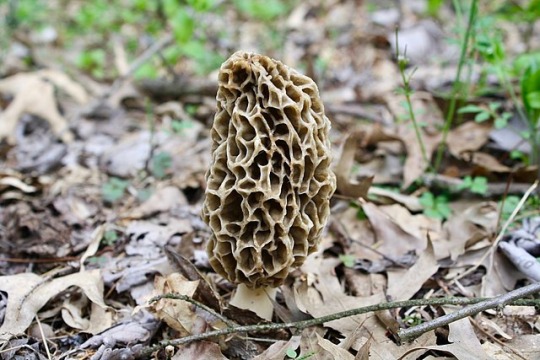
M. americana
Both deciduous and conifer forests may be homes to morels; yellow morels tend toward deciduous, while conifer forests are more likely to feature black morels. A wide variety of tree genera may be associated with morels include but are not limited to Pseudotsuga, Pinus, Abies, Quercus, Fraxinus, Alnus, and Castanea.
However, the half-free morels–M. punctipes (seen below), M. populiphila, and M. semilibera–may have a small space between the bottom edge of the cap and the stipe. The cap has a honeycombed appearance, with surfaces deeply pockmarked with cavities surrounded by brittle ridges that crumble into fragments when crushed. Colors vary, and morel species are often grouped together by cap color; black morels have a dark brown to black cap, while yellow and white morels are more tan to cream.

M. punctipes, cut in half to show hollow centers, and only the upper portion of the caps attached to the stipes. Photo by Chase G. Mayers, CCA-4.0
The stipe may be lightly textured, and is usually lighter in color than the cap, often white, cream, or pale yellow depending on species. Cutting a morel’s stipe open reveals that it is entirely hollow inside. A mature morel is generally around three to six inches high, though larger specimens have been found.

M. americana with the top removed, showing the hollow interior.
The stipe may be lightly textured, and is usually lighter in color than the cap, often white, cream, or pale yellow depending on species. Cutting a morel’s stipe open reveals that it is entirely hollow inside. A mature morel is generally around three to six inches high, though larger specimens have been found.
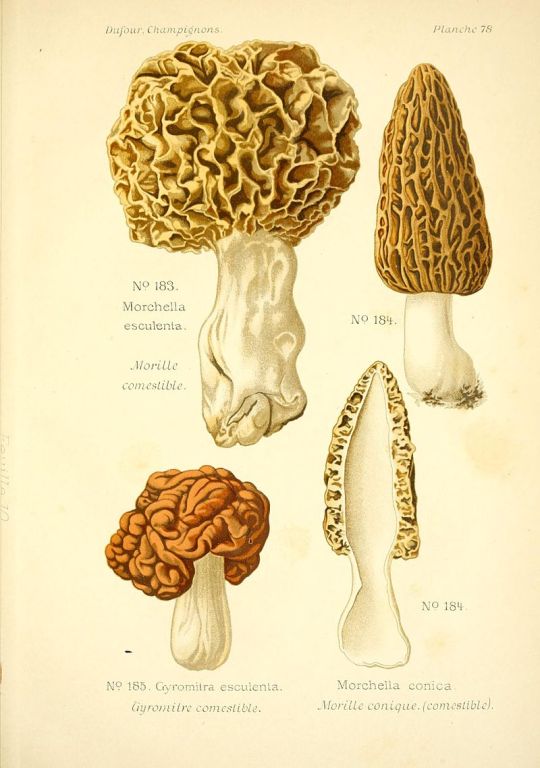
A vintage illustration shows three morels, to include one cut in half to display the hollow center; the mushroom in the lower left is a false morel (Gyromitra esculenta).
Other organisms it could be confused with and how to tell the difference: There are multiple groups of mushrooms that look similar enough to morels to cause confusion; given morels are a popular edible mushroom, consumption of some of these lookalikes has caused serious illness on numerous occasions.

V. bohemica; note that the bottom edge of the cap is not attached to the stipe, and that it has more of a wrinkled appearance than honeycombed. By NeoSporen, CCA-SA-3.0.
Members of the genus Verpa look similar to half-free morels in that the bottom edge of the cap is not attached to the stipe. However, when cut in half the half-free morels have more of the upper portion of the cap attached to the stipe; Verpas only have the very tip attached. Outwardly they do look quite similar to morels overall, often having a conical cap with a honeycombed texture; some may have less distinct cavities and a more “lumpy” appearance rather than honeycombed. The cap of the Verpa is generally smaller in proportion to the stipe than on mature morels. The stipes of young Verpas are full of soft, fluffy hyphae, but they become hollow like morels as they mature.
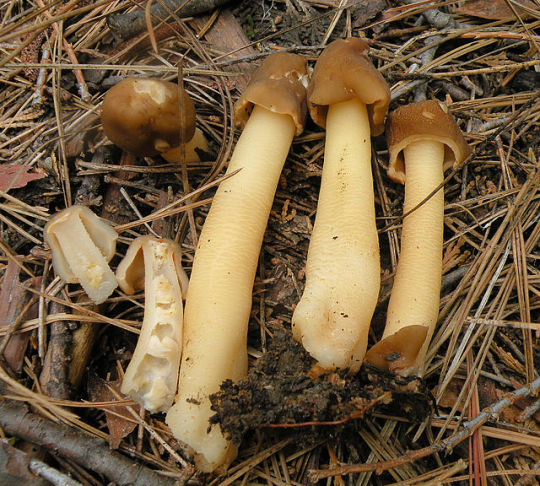
V. conica, showing one cut in half. Note that the cap is only attached to the stipe at the very top, and there is still some fungal hyphae tissue in the center of the stipe. Photo by Jeff Riedenauer (Tamsenite), CCA-SA-3.0.
Like morels, they are considered by some to be edible when thoroughly cooked. However, one study purports that V. bohemica is also toxic, having the same sort of toxins as the false morels I’ll discuss below. Some field guides recommend avoiding the other Verpa species as well due to potential inedibility. Both Verpas and morels fruit in spring, and may sometimes be found in the same area. As someone who would like to become an old, rather than bold, mushroom hunter, I recommend skipping the Verpas and sticking to the true morels, just in case.
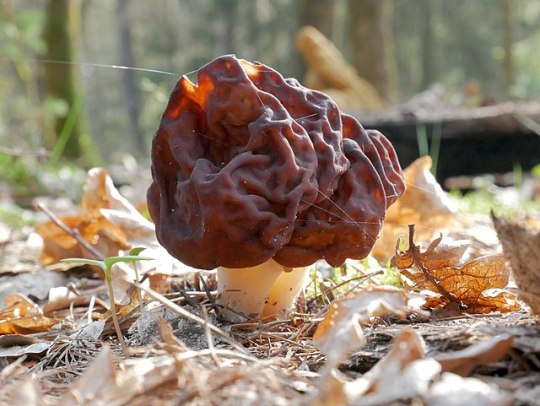
A false morel (Gyromitra spp.); notice that instead of looking like a cone made of honeycomb, it resembles a raisin or a brain on a stalk.
False morels, in the genus Gyromitra, are a more notorious morel lookalike. Several species contain significant levels of gyromitrin, a compound that when boiled or consumed hydrolizes into monomethylhydrazine, a chemical used in making rocket fuel. Consumption may cause gastrointestinal distress, neurological symptoms, kidney and liver failure, coma, and failure of the respiratory and circulatory systems. The most severe cases result in death within a week after consuming false morels. Some species have more gyromitrin than others, and it’s likely that the compound can build up over time in people who eat false morels on a regular basis. While there are purported methods used to reduce or remove gyromitrin from false morels, as a foraging instructor I do not recommend consuming any Gyromitra false morels due to the risk of severe illness.

G. californica. Note that the stipe is not completely hollow inside, but has several cavities divided by fungal tissue. Photo by Alan Rockefeller, CCA-SA-4.0.
So how do you tell the difference? Where true morels look like honeycombed cones, false morels look like brains, oversized raisins, or piles of worms. If you cut a true morel open the stipe will be completely hollow, but the interior of a false morel may have multiple smaller chambers or be completely solid. It is exceptionally important to make sure you get a sure identification on whatever species you are picking, as true and false morels fruit in spring, and sometimes in the same areas.

M. angusticeps
Anything else worth mentioning? Morels are definitely one of those mushrooms you want to cook thoroughly before eating, as raw or undercooked morels can cause gastrointestinal distress. Also, if you hang around mushroom foragers long enough, you’ll hear all sorts of advice–some of it conflicting–about when and where to find morels. It’s true that they fruit in spring, starting in lower elevations where it warms up sooner, and then higher elevations as spring temperatures continue to rise. South-facing slopes that warm up faster with sunlight may also see earlier fruiting. And, of course, places that burned or were logged in the last year or two may see a bumper crop of morels the following spring. Many patches of morel mycelium only last a few years, so the place you found morels one year may not fruit the next.
Beyond that, it’s best to study up on the species of morel that grow in your area. Find out what sorts of habitats they like, if they’re associated with any particular trees, whether they are responsive to burns and other disturbances, and whether there are any toxic look-alikes that grow nearby.
Further reading:
The Great Morel
Mushroom Expert: Morchellaceae
Tom Volk’s Morel Page
Mushroom Appreciation: Morel Mushroom
Did you enjoy this post? Consider taking one of my online foraging and natural history classes, checking out my other articles, or picking up a paperback or ebook I’ve written! You can even buy me a coffee here!
#morels#mushrooms#fungi#fungus#mushroom hunting#mushroom foraging#foraging#wild foods#wild mushrooms#mycology#biology#nature#outdoors#forest#poisonous mushrooms#edible mushrooms
173 notes
·
View notes
Text
A writer’s guide to forests: From the poles to tropics, part 2
Dearest writers, and all who find this guide, big shout out to you. Now let’s get back into things and move ever closer to the equator.
Temperate rainforest
While most people think of rainforests as being a purely tropical environment, several exist in more seasonal areas of the planet.
Location- Coastal regions. The North American temperate rainforest is a thin belt stretching from California, through British Columbia and up into southern Alaska. In the southern hemisphere, the largest forest is found along the southern stretches of the Andes.
Climate- Temperate to subpolar. Conditions are wet, with moisture coming in the form of rain and sea mist. Seasons are variable, with summers being warm and winters cold and snowy.
Plant life- Conifers dominate these forests, with deciduous trees restricted to lower altitudes. In the north, the primary species are Sitka spruce, Douglas fir, red cedar, western hemlock, and giant redwoods. Southern forests are dominated by Podocarps, Monkey puzzle, and southern beech. High humidity means that moss, lichens and ferns grow amongst tree trunks and the forest floor.
Animal life- Whilst more densely populated than the boreal forests, the amount of wildlife is limited by resinous conifer needles, and the lack of plants on the forest floor in denser areas. Most species are arboreal, with weasels, squirrels, and various birds along up the majority of life. Moist conditions mean that there are many types of amphibians and invertebrates that live on the forest floor. Southern hemisphere forests have become host to many invasive species, such as deer, beavers, rats, and ferrets.
How the forest affects the story- The most obvious challenge for characters will be the changing of the seasons. What do your characters do as the days grow shorter and colder? And let’s not forget that rain and mist are common. Damp conditions are a breeding ground for mold and rot, so people will have to come up with ways of keeping them and their possessions dry.Then comes the vegetation. What kind of culture would develop among the tallest trees in the world? Do they live on the forest floor or up in the trees? The density of the canopy can make farming impractical, unless done in clearings or tree top platforms. If your characters and their society are arboreal, then how do they travel between trees? Bridges? Zip-lines? Or do they take inspiration from nature and glide between trees? Imagine if people on the ground meet those from up above. How would these two cultures be different? Would interactions be peaceful, antagonistic, or do they have no contact (at least until the plot requires it)? Being close to the coast, does the sea have an influence on characters and their culture? How would you explain this to someone not familiar with this environment? And you are not limited to the Earth. Remember, the California forests were the stand-in for the forest moon of Endor from Star Wars.
#writing#creative writing#writing guide#writing inspiration#writing prompts#writer on tumblr#writeblr
26 notes
·
View notes
Text
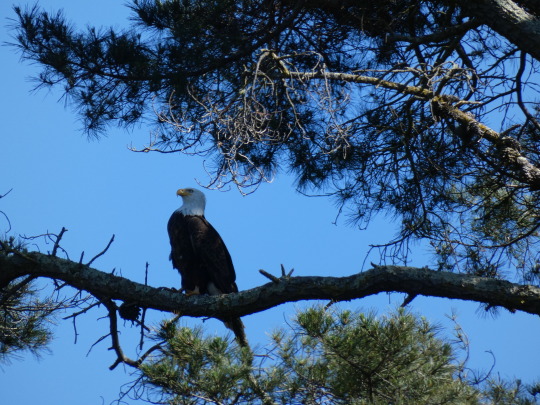
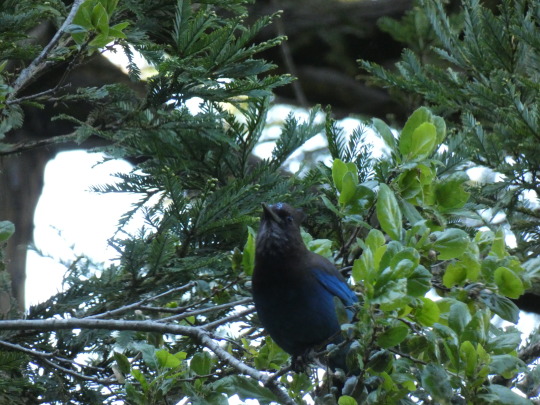
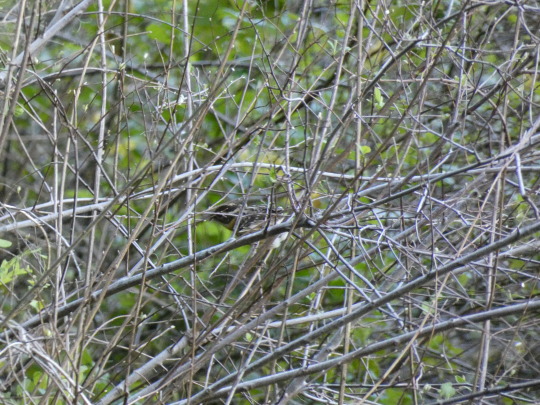




Saturday's Epic Bird Walk
On Saturday I went to small park/recreation area where I hadn't gone birding before, even though it's not far from my house at all.
There's a small artificial lake there, and bald eagles have been spotted there in the past few months. A few minutes after I arrived, a couple stopped to ask me if I'd seen the eagles, and I said I wasn't sure where to look, so they pointed me in the general direction but said they only saw them about once every couple weeks. I told them I didn't think I would be lucky enough to see a bald eagle on my first try.
I knew there was a trail circling the perimeter of the lake; people like to fish there. But I was surprised to find an upper trail on the west side of the park, which climbs a bit above the level of the water and is much less busy (that is, there are fewer people, but more wildlife!). I didn't even know it was there. I admired the wildflowers and enjoyed the birdsong, trying to spot the birds I was hearing. I noticed a turkey vulture soaring in the distance. Then I turned back in the direction I was walking and spotted, perched high up in a tall conifer ahead of me, an enormous bird. It was a bald eagle! Very exciting! I managed to get a couple decent photos of it. This was only my second sighting since using eBird, and my first ever in California.
Not long after that, as I proceeded on the trail, I heard some rustling in the underbrush, which I at first thought must be a bird or squirrel. But then the rustling seemed like it had to be coming from something a little larger. I was looking to try to identify where it was, when suddenly a fox ran across the trail and disappeared into the understory on the other side! I didn't even know we had foxes around here!
I later heard what Merlin claimed was a black-headed grosbeak! It took me a while to spot it, but it appeared to be a female/immature (all (terrible) photos in row 2). This was only my second time seeing this species, and my first time in California; the first time I saw it was actually on the same hike in Oregon where I saw bald eagles.
Other highlights, not all of which I managed to photograph, included a Steller's jay I could report as the coastal subspecies (top row, next to the bald eagle photo), some sort of domestic duck (row 3) which I admired but didn't bother to report, a green heron (bottom row), 2 Wilson's warblers (I don't see those very often), several black phoebes, an immature black-crowned night heron, double-crested cormorants, a killdeer, a band-tailed pigeon, and pied-billed grebes (one of which was vocalising a lot).
A few people stopped to ask me if I'd seen the eagle, so I was pleased to be able to say yes!
7 notes
·
View notes
Photo
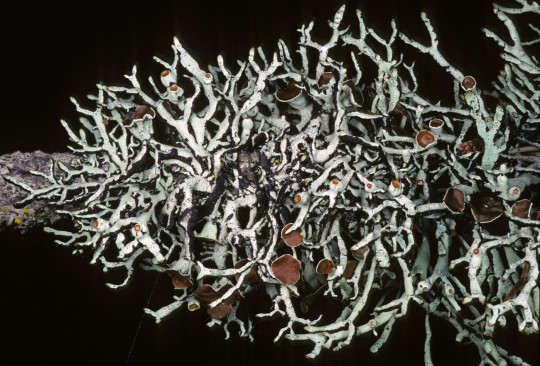
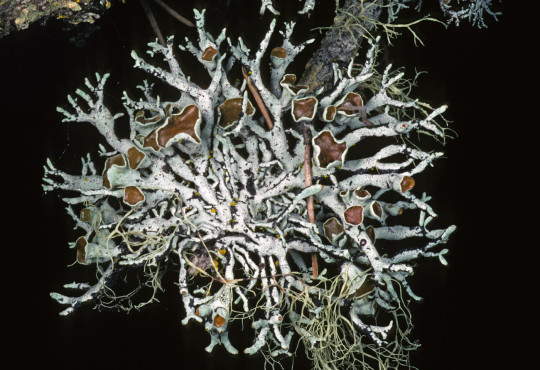






Hypogymnia heterophylla
Seaside bone lichen
My favorite thing about Halloween? Skeletons! I love skeletons, I love bones, I love skulls, I love memento mori, I love the complexity of millions of years of evolution and ecology and the cycle of life and death and returning to nature and uh! It just gets me. But, obviously, liches don’t have a skeleton, or bones. So I will just have to settle for lichens that vaguely look like bones to get my spooky-scary-skeleton-lichen Halloween fix! H. heterophylla is a foliose-fruticose lichen that can only be found on the Pacific coast of North America. It has long, inflated, cartilaginous lobes with irregular branching patterns. The upper surface is pale gray or gray-green, and perforated with small black pores (pycnidia). The edges of the thallus are black, as is the perforated lower surface. It produces short-stalked, urn-shaped apothecia with a concave brown disc. H. heterophylla grows on conifer bark in coastal habitats ranging only from southern British Columbia down to central California. Due to its limited range, it is considered a threatened species in Canada, and action plans for conservation are in place for the 7 colonies present there. If the thought of losing a beautiful friend like this to climate change and urbanization doesn’t scare you, I don’t know what will!
images: source | source | source
info: source | source
#lichen#lichenology#lichenologist#lichenized fungus#fungus#fungi#mycology#ecology#biology#botany#not plants#bryology#systematics#taxonomy#life science#environmental science#Hypogymnia heterophylla#forest#forestry#see the forest for the lichens#I'm lichen it#Hypogymnia#lichen a day#daily lichen post#trypo#trypophobia#nature#naturalist#natural science#beautiful nature
127 notes
·
View notes
Text
Round Three: Changmiania vs Bisticeratops
Changmiania liaoningensis

Artwork by @i-draws-dinosaurs, written by @zygodactylus
Name Meaning: Eternal Sleeper from Liaoning
Time: 125.755 million years ago (Barremian stage of the Early Cretaceous)
Location: Lujiatun Beds, Yixian Formation, Liaoning, China
Changmiania is a gorgeously preserved ornithopod known from the earliest time of the famed Yixian Formation, adding it to the ranks of amazing fossils known from this unique preservational environment. The multiple specimens of this species are found in sleeping poses, curled up on the ground with their legs and arms tucked up against them. This indicates they had been buried alive, possibly inside their own burrows. Given the depositional environment of Yixian is a sort of prehistoric Pompeii, with many dinosaurs covered very quickly in ash and dust from an exploding volcano, this makes a certain degree of sense - perhaps the two little dinosaurs had scurried into their burrow to escape the oncoming tragedy (sorry if I just made you sad), or had been asleep and unaware of the oncoming danger. At only one meter long and less than half a meter tall, Changmiania would have been easily missed in its environment, hiding among the dense vegetation from potential predators. With robust leg bones, it would have been a fast runner, able to move efficiently through the crowded undergrowth. It had a weirdly short neck for ornithischians, and that combined with its short forearms and hands indicates it was fossorial - ie, a digging animal, hence its burrow home and final resting place. Given they were found together, they were probably social creatures as well, living in small family groups. The Yixian was a dense temperate forest, filled with freshwater lakes and a great diversity of plantlife. Conifers, ferns, cycads, horsetails, and early flowering plants filled the environment and indicated a humid, possibly rainforest environment. Periodic wildfires, noxious lake gasses, and volcanic eruptions all lead to regular moments of rapid burial and amazing preservation in this environment - essentially giving us snapshots of how it changed over the course of many millions of years. In the Lujiatun bed specifically, Changmiania was neighbors with Euhelopus, Jeholosaurus, Liaoceratops, Psittacosaurus, Liaoningornis, Daliansaurus, Graciliraptor, Mei, Sinovenator, Sinusonasus, Dilong, Hexing, Incisivosaurus, Shenzhousaurus, and outside of dinosaurs mammals such as Acristatherium, Gobiconodon, Juchilestes, Maotherium, Meemannodon, and Repenomamus (yes, THAT Repenomamus), and the toad Liaobatrachus.
Bisticeratops froeseorum

Artwork by sauriazoicillus, written by @zygodactylus
Name Meaning: Froese’s Dééł Náázíní Horned Face
Time: 74 million years ago (Campanian stage of the Late Cretaceous)
Location: Farmington Member, Kirtland Formation, New Mexico, United States
Bisticeratops is an early Chasmosaurine, known from a partial skull found in the Kirtland Formation. Yet another of a largely growing number of Chasmosaurine taxa from the Campanian of North America, it appeared to resemble Pentaceratops, but was more closely related to later ceratopsians known from the Kirtland formation, as well as one unnamed taxon from the Almond Formation in Wyoming. Interestingly, Bisticeratops shows signs of bite marks from tyrannosaurids, which apparently had begun to heal prior to death. However, we do not know which tyrannosaurid may have left these marks - while the Kirtland Formation is a well studied environment, the Farmington Member has never yielded dinosaurian fossils before now, taking place earlier than the more famous De-Na-Zin of the formation. Like other iterations, the Kirtland was a coastal plain along the western interior seaway, preserving a muddy and sandy environment that would have been filled with a variety of subtropical plants. It is presumable that other dinosaurs lived here besides Bisticeratops and a tyrannosaurid - hadrosaurs, ankylosaurs, pachycephalosaurs, ornithomimosaurs, and dromaeosaurs would all have been possible members of this ecosystem based on the following and preceding ones from this formation.
#dmm#dmm rising stars#dinosaur march madness#dinosaurs#birds#palaeoblr#birblr#bracket#polls#march madness#paleontology#changmiania#round three#bisticeratops
92 notes
·
View notes
Text
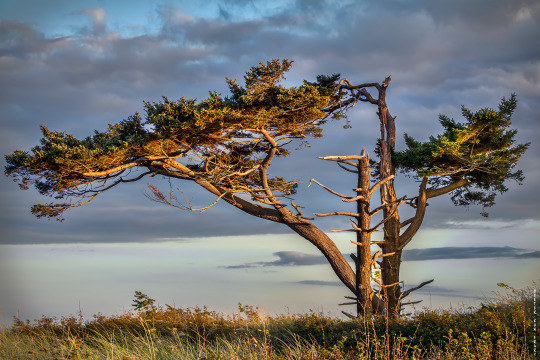
As a young runt growing up during the early 1960s I remember seeing these coastal conifers from afar—probably from Chetzemoka Park or Point Hudson. Instead of weathered conifers, I thought they looked like palm trees on a distant shore. I didn’t see them up close until years later when I was finally old enough to ride a bike down Morgan Hill.
#Chetzemoka Park#Point Hudson#point wilson#port townsend washington#fort worden state park#washington landscape#pacific northwest#original photography
59 notes
·
View notes
Text
the fact that vancouver has such a unique and recognizable ecosystem makes the number of tv shows and movies that film there and pretend to be anywhere but coastal british columbia kind of funny like of course it doesn’t matter that much since the average person can’t distinguish a coastal douglas fir from any other kind of conifer but to me (guy with the bec zone system burned into his brain) it’s always entertaining to see characters insist they’re in iowa while standing amongst red cedar and salal
47 notes
·
View notes
Text
Worldbuilding cuisines
Wet temperate climates:
Cfa and Cwa: Anything goes for these types of cuisines. Note, that many spices to come from this climate zone, such as ginger. These parts of the world can also be transitional climates from more tropical ones, further increasing the number of available spices. And anything goes: mild and fermented, plant-based and spicy, meaty stews with greens. Really, anything goes, just note that in the summer, meat would rot rather quickly, and thus, they might prefer to eat smaller animals. This is the perfect climate zone for rice, so as long as there are enough flat land, rice would be the most basic food, sometimes replaced by buckwheat, tubers or millet were the soil is too rocky. Different varieties would have different amounts of harvests per year, and thus, it would feed a lot of people. Rice might also be quite a popular option. Proximity to the sea might encourage fishing, or gathering kelp or sometimes even water-life domestication. It would also encourage a certain degree of trade, further increasign available foods.
Cfb: Temperate, rainy, very rainy. The semi-long winters and the insiduous cold would encourage the consumption of meat and other animal proteine, especially if it's fatty. It doesn't mean it'll be readily available, but it would make it much more desirable. When meat is not available, nuts would fill that role. The crops that grow best in these climates are barley, rye and oats, which prior to industrial agriculture, would be the main food of the working class. When these are unavailable, tubers such as potato, sweet potato and so on. Proximity to the sea might encourage to add fish and kelp consumption. Slow-cooking and baking might also be more prevalent as a mode of preperation. If after all, one must burn some fuel to heat oneself, might as well use that fuel for cooking. As long as this cuisine has a steady source of fat and starch, one is good to go.
Cfc: Temperate, but colder. Grains would probably be limited to barley and oats, and even then, only in small quantities. Some tubers, such as potatoes, can be grown in such a climate. Preserved meat would probably play and important part in the diet, when plant life isn't as abundont. Given such climates are coastal, it'll probably be fish and sea-life of some kind. Berries and rowan would be a main source of sugar and vitamins. These regions of the world would also be quite good trading spots, and also make trading more obligate, so more non-indiginous foods would be present. If forests are intact, mushrooms stews and conifer-based drinks would be quite prevalent. Seaweed, kelp and lichen would be consummed. Foods would often times be fermented as the main method of preservation. A mostly carniverous diet, both out of lack of available large scale plant food, and because of the cold. Usually fatty and salty.
10 notes
·
View notes
Text




1 note
·
View note
Text
Warbler Showdown; Bracket 1, Poll 6


Townsend's Warbler (Setophaga townsendi)
IUCN Rating: Least Concern
Range: a Western warbler, breeding in British Columbia and southern Alaska and overwintering in the Mexican mountains- though it can sometimes overwinter along coastal California.
Habitat: breeds in tall coniferous and mixed confierous-deciduous forests, most abundantly in unlogged, old-growth forest. Overwinter habitat in California is live oaks and mixed oak-conifer forests, while in Mexico and Central America it includes a variety of montane forest habitats.
Yellow-throated Warbler (Setophaga dominica)
IUCN Rating: Least Concern
Range: The migratory population moves from the Bahamas and Greater Antilles to lowland Eastern and Midwest states; a more sedintary populations seem to live year-round in parts of Florida, Georgia, and Alabama.
Habitat: prefers wetter habitats, such as wooded steam bottomlands and cypress swamps, though they can be found in dry pine or mixed pine-deciduous forests. Also common in loblolly pine stands.
Image Sources: Townsend's (David Turgeon); Yellow-throated (Tyler Ficker)
11 notes
·
View notes